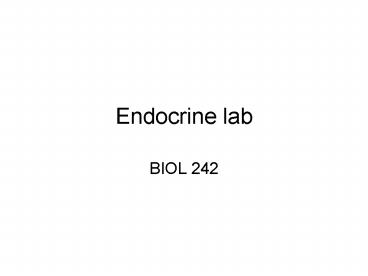Endocrine lab - PowerPoint PPT Presentation
1 / 19
Title:
Endocrine lab
Description:
Know the structures and functions of each of the following ... Play at your own risk (grin!) Pancreas. BE ABLE TO IDENTIFY THE STRUCTURES LABELED ON THE SLIDES ... – PowerPoint PPT presentation
Number of Views:24
Avg rating:3.0/5.0
Title: Endocrine lab
1
Endocrine lab
- BIOL 242
2
- OBJECTIVES
- Identify and name the major endocrine organs of
the body - Know the structures and functions of each of the
following glands, include the hormones that are
produced by each gland and how they are
controlled. Hypophysis (pituitary) Suprarenal
Thyroid Parathyroid Gonads Pancreas
Pineal - Indicate how hormones contribute to body
homeostasis - give examples of hormonal actions. - What is the structural and functional
relationship between the hypothalamus and the
pituitary? - Identify the histology structures of the glands
provided on slides. - STRUCTURES AND WORDS TO KNOW
- Lab 27
- Pituitary gland anterior/posterior Hormones
FSH, LH, ACTH, TSH, GH, PRL, MSH, OT, ADH - For the slides - try to find acidophils and
basophils, chromophobes/pituicytes - Thyroid gland Hormones T3 and T4, CT
- For the slides - follicle cells
- Parathyroid glands Hormones PTH
- For the slides - oxyphil (large ones) and
chief cells - Adrenal gland Hormones EPI, NOREPI, mineral
corticoids, glucocorticoids, gonadocorticoids - For the slides - medulla, three zones, capsule
- Pancreas Hormones Insulin, glucagon
- For the slides - alpha and beta cells
- Gonads testes/ovaries Hormones Estrogens,
progesterone, testosterone
3
OBJECTIVES
- Identify and name the major endocrine organs of
the body - See the list in the lab assignments
- Know the structures and functions of each of the
following glands, include the hormones that are
produced by each gland and how they are
controlled - Hypophysis (pituitary)
- Suprarenal
- Thyroid
- Parathyroid
- Gonads
- Pancreas
- Pineal
- Indicate how hormones contribute to body
homeostasis - Be able to give examples of hormonal actions.
- What is the structural and functional
relationship between the hypothalamus and the
pituitary? - Identify the histology structures of the glands
provided on slides.
4
Pituitary gland
- Be able to identify which hormone comes from the
anterior and posterior pituitary - Hormones FSH, LH, ACTH, TSH, GH, PRL, MSH, OT,
ADH
5
Pituitary gland
6
Pituitary gland (the hyperlinks work on this
page)
PARS DISTALIS chromophils (50) and chromophobes
(50). The chromophils can be further subdivided
into acidophils (40) and basophils (10). The
acidophils secrete GH (somatotropes) and
prolactin (mammotropes). Basophils secrete TSH
(thyrotropes), LH (gonadotropes), FSH
(gonadotropes), and ACTH (corticotropes). PARS
NERVOSA main cell type here is a glial or
supporting cell called a pituicyte . The bulk of
the pars nervosa consists of axons from neurons
in the supraoptic and paraventricular nuclei of
the hypothalamus. PARS INTERMEDIA rudimentary
in humans, lies between the pars distalis and
pars nervosa. BE ABLE TO IDENTIFY THE
STRUCTURES WITH HYPERLINKS
7
chromophobes
8
Thyroid gland
- Hormones T3 and T4
9
Thyroid gland
BE ABLE TO IDENTIFY THE STRUCTURES LABELED ON THE
ABOVE SLIDE
10
Parathyroid glands
- Hormones PTH
11
Parathyroid glands
- oxyphil (large ones) and chief cells
Parathyroid Glands Red arrows
Oxyphil/Principle Cells Yellow arrow - Chief
Cells BE ABLE TO IDENTIFY THE STRUCTURES LABELED
ON THE SLIDE
12
Adrenal gland
- Hormones EPI, NOREPI, mineral corticoids,
glucocorticoids, gonadocorticoids
13
Adrenal gland
BE ABLE TO IDENTIFY THE STRUCTURES LABELED ON THE
SLIDE
14
Pancreas
- Hormones Insulin, glucagon
http//www.youtube.com/watch?vBtsQxUYHXbw Play
at your own risk (grin!)
15
Pancreas
BE ABLE TO IDENTIFY THE STRUCTURES LABELED ON THE
SLIDES
16
Gonads testes/ovaries
- Hormones Estrogens, progesterone, testosterone
17
Gonads testes/ovaries
Which is which?
18
Thymus gland
- Hormones Thymosin
Panoramic view of adult thymus, largely replaced
with adipose tissue. There are recognizable
remnants of thymic lymphatic tissue, however, and
Hassall's corpuscles are still present in the
medulla. Why is there so much adipose tissue?
19
Pineal body
- Hormones Melatonin
THE SLIDES OF THE PINEAL ARE NOT VERY
DISTINGUISHING It consists of connective tissue,
blood vessels, glial cells, and pinealocytes
(which secrete melatonin). Pinealocytes have
larger, lighter staining nuclei and glial cells
have small darker staining nuclei. With age,
calcified formations appear in the pineal gland
(brain sand or corpora aranacea ).































